13 Small House Design Principles (The Illustrated Guide)
15 Jan 2023

Table of contents
- Vary Ceiling Heights
- Extend Lines of Sight
- Optimize Energy Flow
- Define Clear Zones of Use
- Build Up, Not Out
- Make Spaces Multifunctional
- Don’t Make Everything Small
- Do More With Less
- Build-in Custom Furniture
- Minimize Hallways
- Use Smaller Appliances
- Maximize Natural Light
- Utilize Outdoor Living Space
This is a list of the best small house design principles that architects use to design small spaces that feel big.
If you struggle to make small designs work efficiently, then you will love this post! You can use these tricks to get maximum value from your available space, no matter how small your home is.
Let’s get started.
Here are the top 13 small house design principles:
1. Vary Ceiling Heights

Tiny houses normally need some rooms to be compact, but that doesn’t mean they have to feel small. One secret to maximizing space is to vary ceiling heights between rooms.
In a small room, try raising the ceiling height to add a vertical dimension to the space. Extra headroom can make a small room feel bigger without increasing the floor area.
High ceilings can also be used as a wow factor, particularly when you enter via a room with a lower ceiling.
In a large room, you can afford to lower the ceiling to the minimum allowable height without making the space feel too small. This trick can add a few inches of extra height to your level above.
By playing with ceiling heights you can make small spaces feel bigger or add extra space to other levels. By picking a variety of heights you can maintain a comfortable sense of space in rooms of any size, plus a journey through your home can be a more interesting one.
2. Extend Lines of Sight
One secret to making space feel bigger is to extend lines of sight further than the room boundaries.
This works because of a neat psychological trick; When you see beyond the walls, you can feel less enclosed by them, and your sense of space increases.
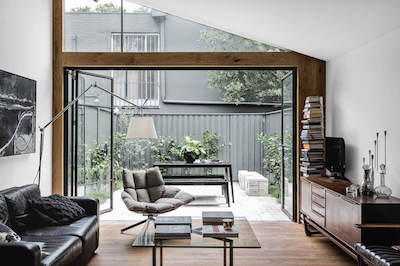
One of the best ways to extend lines of sight is with windows, but where you place the opening can make a big difference to your sense of space.
A window in the middle of a wall allows you to look out, but the extents of the room can still feel largely unchanged.
Instead, try placing full-height windows down either side of a wall. Edge and corner windows can visually break the enclosing structure of a rectangular room and create a greater illusion of space.
This same principle can work for high windows that run along the ceiling and also low windows at floor level.
Make an entire wall of glass to take this idea even further.

Try using edge-to-edge glass sliding doors to open onto a balcony or backyard deck, this will make your outside space feel like it’s part of the room. This effect is most convincing when the side surfaces of the room are uninterrupted by the window frame, so inset window frames flush to the floor, walls, and ceiling if you can.
But windows don’t have to be external.
Add windows between internal rooms to create more visual space. For example, a bedroom can feel much bigger when it has overhead windows that open onto a neighboring hallway.
The best thing about this internal window trick is it works both ways, the hallway can feel bigger too!
3. Optimize Energy Flow
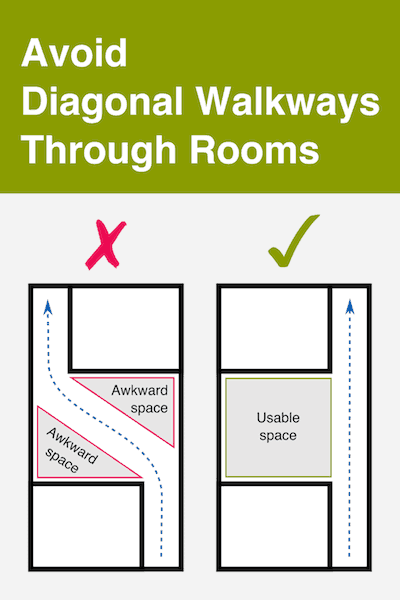
Awkward spaces can destroy the utility of a tiny house and make spaces feel constricted. To overcome this feeling, remove any kinks from your design to allow for an unrestricted flow of energy.
Here are some tricks you can use to achieve this:
Use clean, flowing lines for the main walking paths through your house.
Avoid walkways that intersect a room diagonally as this will limit furniture placement to awkward triangular areas.
Allow extra space at intersections and doorways so people can pass each other easily.

Separate frequently-accessed items so multiple people can use them at once without bumping into one another. For example, in the kitchen, your fridge, stovetop, and sink should ideally form points on a triangle. This is often referred to as the kitchen work triangle but I prefer to call it the Kitchen Work Heart because the kitchen is the heart of the home.
Opt for open plan living. With fewer walls, your space can feel less boxed in and restricted.
By smoothing out the energy flow within a house and removing awkward kinks, you can create a space that’s a pleasure to live in regardless of its size.
Learn more about the benefits of open plan and semi-open plan living spaces and see which is best for you.
Croe Architects also have an office in Cheltenham, along with Hitchin
4. Define Clear Zones of Use
Open plan living spaces that are not well designed can contain gaps that are difficult to use. By clearly defining zones of use within a room, you can eliminate ambiguous areas and ensure that every inch of space has a useful purpose.
Here are some tricks for creating well-defined zones of use:

Change of flooring
To highlight a change of zone, try using different flooring materials. For example, change from timber to tiles, or for a more flexible method, rugs can achieve the same result.
You can also change the floor level. Try creating a step up or down when entering another zone.
Change of ceiling height
Some rooms can have lower ceilings, such as kitchens, try lowering your kitchen ceiling to differentiate it from the remainder of your open plan living space.
Add a loft space above your kitchen and you can effectively double the usable space at the same time.
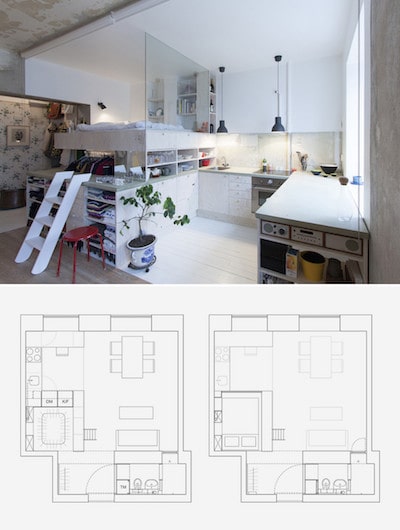
Kitchen cabinetry
You can clearly define where your kitchen ends with the layout of your cabinets.
A breakfast bar, perpendicular to a side wall, can draw an imaginary line across the room, signaling the edge of a kitchen. Or line up the ends of benches on both sides of the room so they communicate a consistent 'end of zone'.
Furniture placement
Careful placement of furniture can help to divide a space into specific zones of use.
One of the best examples is with couches. You can place a couch in the middle of a room and the back of the couch can clearly define the boundary of the lounge area. This works great for straight and corner couches.
5. Build Up, Not Out

If you only have a small area of land to build on and you need more space, the cheapest way to go is up!
By adding additional stories, it’s possible to create a fully functional home on a painfully small footprint. For excessively tiny sites, you can even make use of one room per level.
This concept of ‘building up’ can also be utilized within rooms. A loft can add a layer of usable space without requiring an extra story.
The best thing about loft spaces is they avoid the design restrictions that normally apply to rooms, this is because they are not considered habitable space.
Lofts are free to use lower ceiling heights, this makes them perfect for non-standing activities like sleeping, storage, kids play areas, or seating.
Another benefit with lofts is they don’t require full stairs. A ladder is a perfectly acceptable method of accessing a loft space plus ladders take up much less room than stairs. Ladders can also be movable, making your space even more versatile.
By thinking in three dimensions and designing with more height it’s possible to squeeze even more value out of your space.
6. Make Spaces Multifunctional
When space is limited, one secret to fitting more in is to give multiple uses to each space... Enter multifunctional design.
Here are a few examples.
Can’t fit both a lounge room and a dining area? Why not use a transformable coffee table and folding chairs to make the one space do both jobs.
The Alzare Square – Transforming Coffee Table can seat up to six people when folded out as a dining table, and it transforms in seconds!
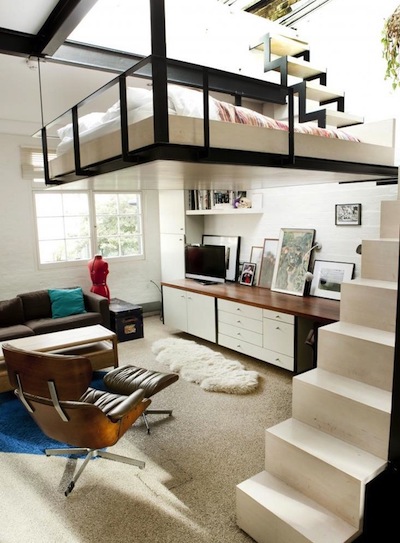
Can’t fit both a home office and a bedroom? Try lifting your bed into a sleeping loft to make room for a work area underneath. Or try using a fold-up Murphy Bed to save space during the day.
No room for a laundry? Place a combo washer-dryer under your kitchen bench and use a large kitchen sink that can double as a laundry tub.
By doubling (or tripling) the functions of each space in your home, you can fit everything you need, even in a limited area.
7. Don’t Make Everything Small
It’s tempting to make everything compact in a small house so you can include as much as possible, but this is a big mistake.
A small house should never feel claustrophobic.

For a small house to feel comfortable, you need at least one generously sized area where you can feel free to stretch out and relax.
Jay Shafer often cited as the founder of the tiny house movement, captures this idea perfectly in his Tumbleweed house designs. Jay’s small house plans almost always include a ‘great room’ that is much more spacious than the other utility areas.
A great room, with an ample floor area, is also a flexible space that can be used for many different activities such as guest sleeping or yoga.
But it’s not just rooms that shouldn’t always be small.
You can include one or two large fixtures to make a small space feel bigger such as a generously sized kitchen sink or a big picture window.
A small house with a full-sized bath can be another spacious place to relax in luxury.
8. Do More With Less
With a small house, quality is much more important than quantity.
Don’t force things to fit when it causes them to feel subpar, squashed, or unloved. Instead, I recommend making some hard choices and only including things that can be given the space that they deserve.
If every room is a joy to use then your whole house will be a pleasure to live in.
Tweet this
The overall feeling of your home comes from the sum of all its parts, so if every room is a joy to use then your whole house will be a pleasure to live in.
9. Build-in Custom Furniture
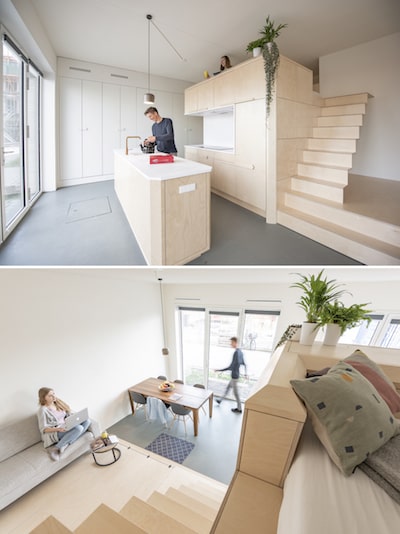
In tiny rooms, you can utilize limited space more effectively by replacing freestanding furniture with custom, built-in fixtures.
Here are some examples:
Use the awkward space under your staircase for storage with an assortment of cupboards, shelves, and draws of different shapes.
Replace wardrobes with built-in closets to add extra storage right up to your ceiling.
Install a cafe-style bench seat or booth and gain additional under-seat storage in your dining area.
10. Minimize Hallways
There is nothing inherently wrong with hallways, but in a small house, they tend to be an ineffective use of your valuable space.
Every square foot of hallway that you eliminate becomes part of another room where the space can often be put to greater use.

Here are my favorite tricks to reduce hallways.
Move bedrooms upstairs and make the ground floor open plan living space, this eliminates the need for a hall past a bedroom to access the front door.
Access bedrooms directly from the living space. If privacy is of concern, then a small alcove can be used to block direct lines of sight into a room.
Place stairs in the center of the house so hallways are not needed past one bedroom to access another. This is especially useful within narrow buildings because it allows rooms to be the full width of the house.
Can't eliminate your hallway? Use my tricks to make your hallway a multifunctional space instead, see my article for details Hallways: Are They a Waste of Space?
11. Use Smaller Appliances
When every inch of space matters, it can sometimes be beneficial to use slightly smaller appliances and fixtures to create a little extra room.
In a small house with fewer occupants, you may not need the biggest sized appliances anyway.
Buy a narrower fridge, or a bar fridge to create extra bench space in your kitchen.
Install a single drawer dishwasher and gain a cupboard underneath.
Use a washer / dryer combo unit that takes up half the space.
12. Maximize Natural Light

Rooms flooded with natural light can feel bigger and inviting so it's a good idea to add as many windows as possible in a small house.
Natural sunlight also reduces your lighting costs and if you incorporate a passive solar design then you can save money on heating and cooling all year round.
If you have a dark room deep within your house, try exposing sunlight via one of these clever window alternatives:
- Skylights
- Light tubes
- Fiber optics
- Light wells
- Internal windows
- Mirrors
- Glass floors
13. Utilize Outdoor Living Space
When the weather is good, a well-designed outdoor entertaining area can add valuable living space to a small house.

I learned the true value of outside living when I bought my first house in 2006.
It was an old terrace house with an attic conversion, barely 13 feet wide (4.2m) and the land was only 947 square feet (88 square meters). There was only one super-tiny living space and the kitchen was practically nonexistent. It was extremely small, but I loved it.
On the day we moved in, we quickly discovered that it was impossible to get our couch inside, our doors were only 31 inches wide (80cm) and the couch did not disassemble. So while we figured out what to do, we placed the couch outside, under the backyard awning.
And that’s where it stayed!
Our inside living space became a dedicated dining area and our backyard turned into an amazing garden lounge room. It was unorthodox, but the climate in Sydney, Australia meant that we could enjoy the space for at least 10 months of the year.
Another unintended side effect of the arrangement was just how much time we spent gardening. Every time we sat on that couch we looked at the garden, we noticed plants that needed tending to, and we pottered around creating a beautiful outside garden room.
Conclusion
A small house is not a problem, it’s an opportunity to get creative.
I encourage you to experiment with these design principles and to master the art of maximizing space in tiny houses. With a bit of perseverance, you can create a truly unique home that will be a pleasure to live in no matter how small it is.
Want to know how small houses can save you money? Read my article on the benefits of small houses to learn just how many ways they can help you to save.
How big is a small house exactly? Find out here: Small House Definition.


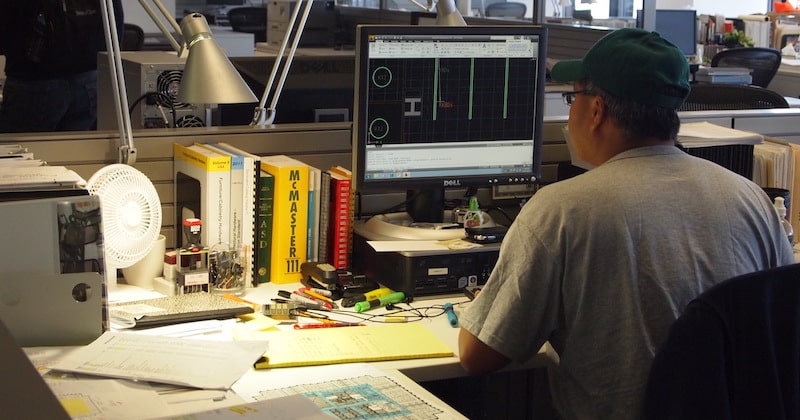

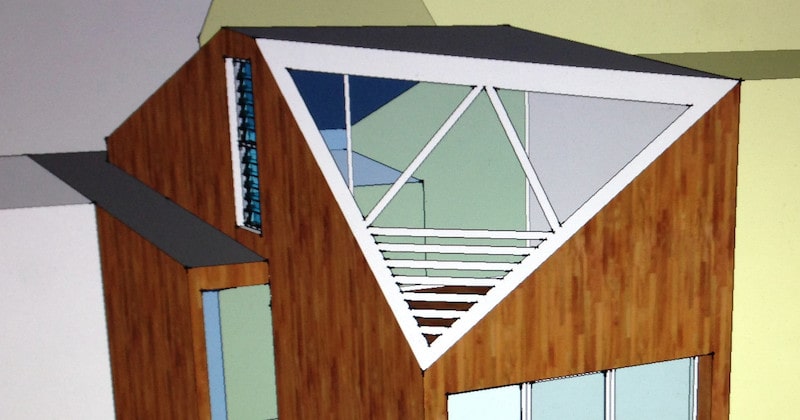
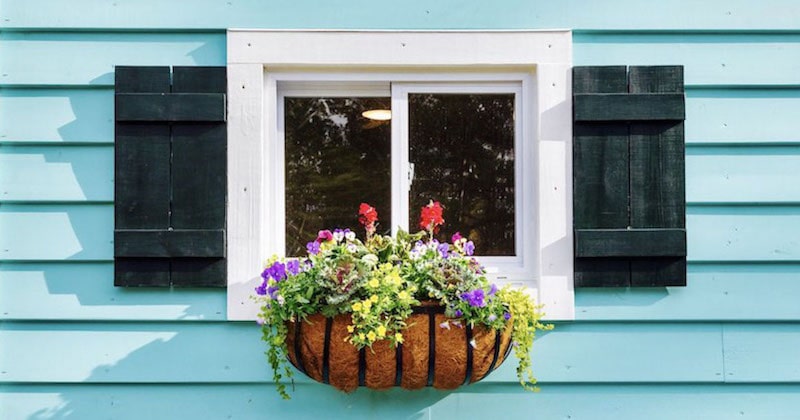
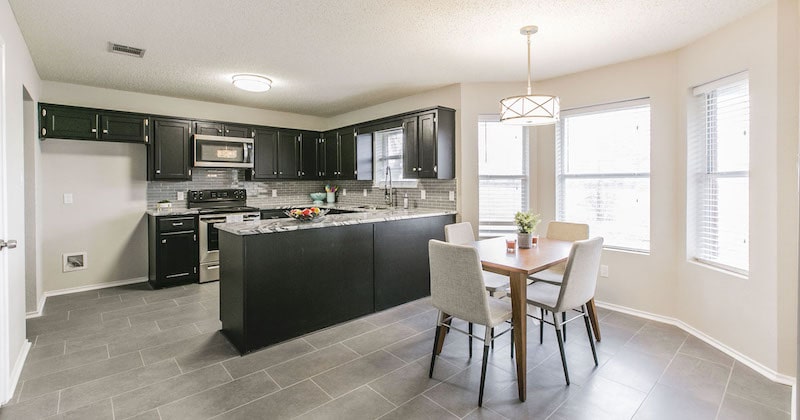

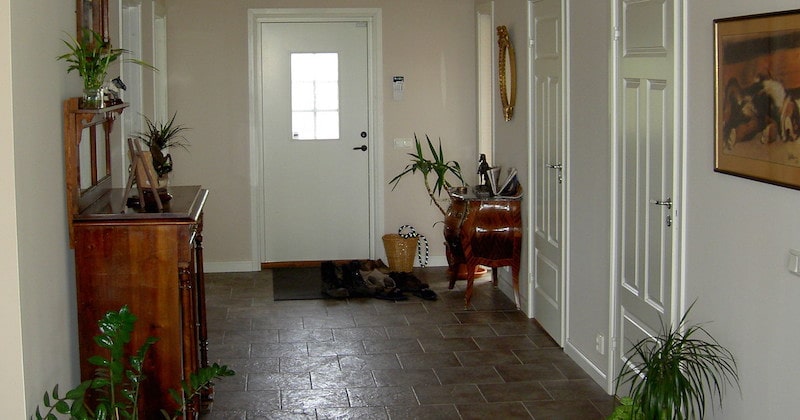


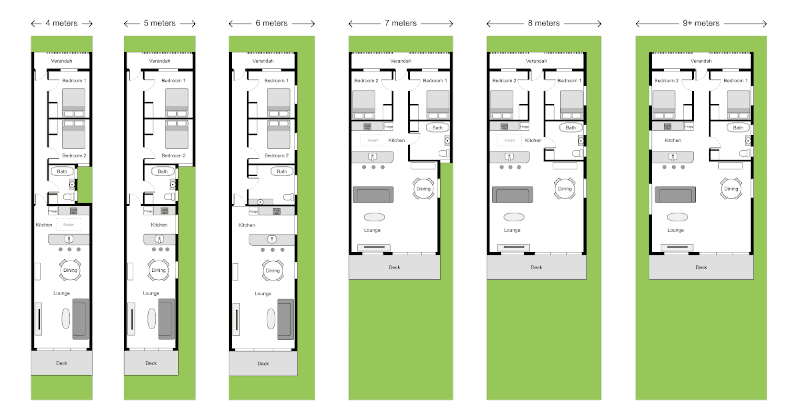
 Web design
Web design
 Architecture
Architecture
 Life drawing
Life drawing
 Art gallery
Art gallery
 Synesthesia
Synesthesia
 Comics
Comics